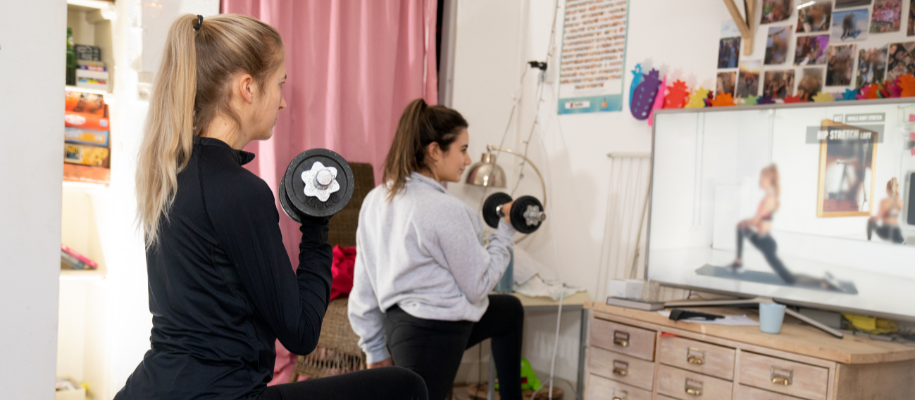As a college student, it can be tough to maintain a regular exercise routine when you're juggling classes, assignments, and extracurricular activities. However, with a few simple tips and tricks, it's possible to create an effective routine that lets you keep active right in your dorm room. Here are some easy steps to get started, plus equipment options you can hide away in a small space.
Setting your workout routine
First, it's important to find the right type of exercise that works for you. Some students prefer yoga, while others prefer more high-intensity workouts like cardio or strength training. Whatever type of exercise you choose, make sure it's something you enjoy and look forward to doing.
Once you've found the type of exercise you like, scheduling it into your daily routine is essential. This could mean setting aside a specific time each day to exercise or making simple day-to-day swaps such as taking the stairs instead of the elevator or going for a walk during your break between classes. Sticking to a workout routine is much easier when you embed it into your regular schedule.
Be realistic and gentle with yourself
When setting up your exercise routine, it's also important to be realistic. If you're new to working out, start with small, achievable goals, such as exercising for 20–30 minutes a few times a week. As you become more comfortable, you can gradually increase the amount, duration, and intensity of your workouts. It's also important to prioritize rest and recovery. Make sure you're getting enough sleep each night and allow yourself time to recharge. This could mean taking a day off from exercise each week or incorporating active recovery such as yoga or stretching. Additionally, autoregulation exercises like deep breathing and meditation can help you manage your stress levels and improve your emotional and mental health. Pay attention to your body's distress signals and adjust your routine accordingly. If you're feeling physically or mentally stressed, it might be time to change your routine or seek support from friends, family, or resources on campus.
Get creative
Don’t be afraid to get creative with your workouts! There are a variety of exercises that can be done in small spaces like dorms. For example, bodyweight exercises such as lunges, push-ups, and squats can be done without any equipment. There are also many online workout classes and resources available if you want to follow along a set routine.
Related: Simple and Effective Exercise Routines for the Busy Student
Choosing exercise equipment for your dorm
When exercising in a dorm room, it's important to consider space limitations and noise restrictions. Here are a few equipment options that are compact, versatile, and suitable for a dorm setting:
- Resistance bands: Resistance bands are lightweight, portable, and incredibly versatile. They come in various resistance difficulties, allowing you to customize your workouts. You can use resistance bands for strength training exercises targeting different muscle groups, such as bicep curls, squats, or lateral leg raises. They can also be used for stretching and mobility exercises.
- Adjustable dumbbells: Opt for a set of dumbbells that can be built and dissembled for easy storage. These allow you to adjust the weight according to your preference for exercises such as dumbbell presses, lunges, and rows. With adjustable dumbbells, you can effectively target multiple muscle groups without needing a full rack of weights.
- Yoga mat: A yoga mat is a piece of equipment that provides cushioning and support for various exercises, including yoga, Pilates, and bodyweight workouts. It can also be a comfortable surface for stretching or core workouts. A yoga mat is lightweight and easy to store rolled up when not in use.
- Jump rope: Jumping rope is a fantastic cardio exercise that requires minimal space. It's an effective way to increase your heart rate, burn calories, and improve coordination. Look for an adjustable jump rope with a lightweight design.
- Stability ball: Also known as an exercise ball or Swiss ball, a stability ball can be used for many exercises that engage your core muscles and improve balance and stability, including ball squats, planks, or back extensions. It can also replace a traditional desk chair, allowing you to engage your core muscles while sitting.
Remember, it's essential to follow any guidelines or rules set by your college regarding exercise equipment usage and noise levels in dorms. And always ensure the equipment you choose is safe, appropriate for your fitness level, and used with proper form.
Related: Working Out Your Mental Health: 3 Benefits of Regular Exercise for Students
Developing a routine that works for you is critical to achieving peak mental and physical health as a student. By prioritizing regular exercise, healthy eating, and social activities—plus listening to your body's needs—you can maintain a balanced and healthy lifestyle that supports the demands of college.
Get more advice on balancing responsibilities, staying healthy, and living it up on campus in our Student Life section.





